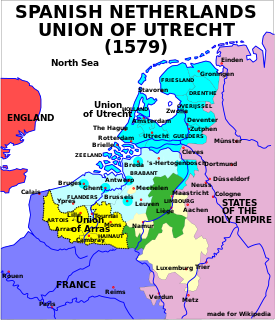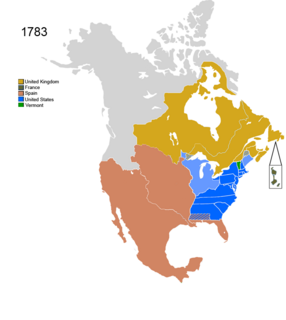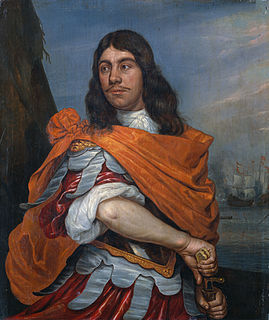Related Research Articles

The Dutch West India Company was a chartered company of Dutch merchants as well as foreign investors. Among its founders was Willem Usselincx (1567–1647) and Jessé de Forest (1576–1624). On 3 June 1621, it was granted a charter for a trade monopoly in the Dutch West Indies by the Republic of the Seven United Netherlands and given jurisdiction over Dutch participation in the Atlantic slave trade, Brazil, the Caribbean, and North America.

The Union of Utrecht was a treaty signed on 23 January 1579 in Utrecht, Netherlands, unifying the northern provinces of the Netherlands, until then under the control of Habsburg Spain.

Hugo Grotius, also known as Huig de Groot and in Dutch as Hugo de Groot, was a Dutch humanist, diplomat, lawyer, theologian, jurist, poet and playwright.

Albert VII was the ruling Archduke of Austria for a few months in 1619 and, jointly with his wife, Isabella Clara Eugenia, sovereign of the Habsburg Netherlands between 1598 and 1621. Prior to this, he had been a cardinal, archbishop of Toledo, viceroy of Portugal and Governor General of the Habsburg Netherlands. He succeeded his brother Matthias as reigning archduke of Lower and Upper Austria, but abdicated in favor of Ferdinand II the same year, making it the shortest reign in Austrian history.

Johan van Oldenbarnevelt, Heer van Berkel en Rodenrijs (1600), Gunterstein (1611) and Bakkum (1613) was a Dutch statesman who played an important role in the Dutch struggle for independence from Spain.

Freedom of the seas is a principle in the international law and sea. It stresses freedom to navigate the oceans. It also disapproves of war fought in water. The freedom is to be breached only in a necessary international agreement.

The Eighty Years' War or Dutch War of Independence (1568–1648) was a revolt of the Seventeen Provinces of what are today the Netherlands, Belgium and Luxembourg against Philip II of Spain, the sovereign of the Habsburg Netherlands. After the initial stages, Philip II deployed his armies and regained control over most of the rebelling provinces. Under the leadership of the exiled William the Silent, the northern provinces continued their resistance. They eventually were able to oust the Habsburg armies, and in 1581 they established the Republic of the Seven United Netherlands. The war continued in other areas, although the heartland of the republic was no longer threatened. This included the origins of the Dutch colonial empire, which began with Dutch attacks on Portugal's overseas territories. At the time, this was conceived as carrying the war with the Spanish Empire overseas due to Portugal and Spain's being in a dynastic union.

Law of the sea is a body of international law governing the rights and duties of states in maritime environments. It concerns matters such as navigational rights, sea mineral claims, and coastal waters jurisdiction.

The Pax Hispanica refers to a period of twenty-three years from 1598 to 1621, when Spain disengaged from the European wars of religion that afflicted Europe during the previous century. Peace was signed with the Kingdom of France, the Kingdom of England, and the Dutch United Provinces. This roughly corresponds to the rule of Philip III of Spain

The Twelve Years' Truce was the cessation of hostilities between the Habsburg rulers of Spain and the Southern Netherlands and the Dutch Republic as agreed in Antwerp on 9 April 1609. It was a watershed in the Eighty Years' War, marking the point from which the independence of the United Provinces received formal recognition by outside powers. For Spain the Truce was seen as a humiliating defeat as they were forced to make several sacrifices but they scarcely got anything in return. For the time of its duration however the Truce allowed King Philip III and his favorite minister the Duke of Lerma to disengage from the conflict in the Low Countries and devote their energies to the internal problems of the Spanish Monarchy. The Archdukes Albert and Isabella used the years of the Truce to consolidate Habsburg rule and to implement the Counter-Reformation in the territories under their sovereignty.
Santa Catarina was a Portuguese merchant ship, a 1500-ton carrack, that was seized by the Dutch East India Company during February 1603 off Singapore. She was such a rich prize that her sale proceeds increased the capital of the V.O.C by more than 50%. From the large amounts of Ming Chinese porcelain captured in this ship, Chinese pottery became known in Holland as Kraakporselein, or "carrack-porcelain" for many years.

The Dutch–Portuguese War was an armed conflict involving Dutch forces, in the form of the Dutch East India Company and the Dutch West India Company, against the Portuguese Empire. Beginning in 1602, the conflict primarily involved the Dutch companies invading Portuguese colonies in the Americas, Africa, and the East Indies. The war can be thought of as an extension of the Eighty Years' War being fought in Europe at the time between Spain and the Netherlands, as Portugal was in a dynastic union with the Spanish Crown after the War of the Portuguese Succession, for most of the conflict. However, the conflict had little to do with the war in Europe and served mainly as a way for the Dutch to gain an overseas empire and control trade at the cost of the Portuguese. English forces also assisted the Dutch at certain points in the war. Because of the commodity at the center of the conflict, this war would be nicknamed the Spice War.
Mare clausum is a term used in international law to mention a sea, ocean or other navigable body of water under the jurisdiction of a state that is closed or not accessible to other states. Mare clausum is an exception to mare liberum, meaning a sea that is open to navigation to ships of all nations. In the generally accepted principle of international waters, oceans, seas, and waters outside national jurisdiction are open to navigation by all and referred to as "high seas" or mare liberum. Portugal and Spain defended a Mare clausum policy during the age of discovery. This was soon challenged by other European nations.

The Peace of Paris of 1783 was the set of treaties that ended the American Revolutionary War. On 3 September 1783, representatives of King George III of Great Britain signed a treaty in Paris with representatives of the United States of America—commonly known as the Treaty of Paris (1783)—and two treaties at Versailles with representatives of King Louis XVI of France and King Charles III of Spain—commonly known as the Treaties of Versailles (1783). The previous day, a preliminary treaty had been signed with representatives of the States General of the Dutch Republic, but the final treaty which ended the Fourth Anglo-Dutch War was not signed until 20 May 1784; for convenience, however, it is included in the summaries below.

The Dutch Revolt (1566–1648) was the revolt in the Low Countries against the rule of the Habsburg King Philip II of Spain, hereditary ruler of the provinces. The northern provinces eventually separated from the southern provinces, which continued under Habsburg Spain until 1714. The northern provinces adopted Calvinism and Republicanism whereas the southern provinces became wholly Catholic again due to the expulsion of Protestants and the efforts of the Counter-Reformation and remained under absolutist rule. The Dutch Revolt has been viewed as the seedbed of the major democratic revolutions from England, to America to France.

In the history of the Dutch Republic, Orangism or prinsgezindheid was a political force opposing the Staatsgezinde (pro-Republic) party. Orangists supported the Princes of Orange as Stadtholders and military commanders of the Republic, as a check on the power of the regenten. The Orangist party drew its adherents largely from traditionalists – mostly farmers, soldiers, noblemen and orthodox Catholic and Protestant preachers, though its support fluctuated heavily over the course of the Republic's history and there were never clear-cut socioeconomic divisions.

Mare Liberum is a book in Latin on international law written by the Dutch jurist and philosopher Hugo Grotius, first published in 1609. In The Free Sea, Grotius formulated the new principle that the sea was international territory and all nations were free to use it for seafaring trade. The disputation was directed towards the Portuguese Mare clausum policy and their claim of monopoly on the East Indian Trade. Grotius wrote the treatise while being a counsel to the Dutch East India Company over the seizing of the Santa Catarina Portuguese carrack issue. The work was assigned to Grotius by the Zeeland Chamber of the Dutch East India Company in 1608.

The Adoration of the Magi is a very large oil painting by the Flemish Baroque painter Peter Paul Rubens. He first painted it in 1609 and later gave it a major reworking between 1628 and 1629 during his second trip to Spain. It is now in the Museo del Prado in Madrid.

The Sharp Resolution was a resolution taken by the States of Holland and West Friesland on 4 August 1617 on the proposal of the Land's Advocate of Holland, Johan van Oldenbarnevelt, in the course of the Arminian-Gomarist, or Remonstrant/Counter-Remonstrant controversy that was disturbing the internal politics of the Dutch Republic during the Twelve Years' Truce. The resolution brought serious disagreements about the interpretation of the Union of Utrecht, that had long simmered, into focus. It started a political conflict that eventually brought down the Oldenbarnevelt-regime and led to Oldenbarnevelt's arrest on 29 August 1618, together with his colleagues Hugo Grotius, Rombout Hogerbeets, and Gilles van Ledenberg, and their 1619 trial, which resulted in their conviction of high treason, and Oldenbarnevelt's execution on 13 May 1619.
Benjamin Aubery du Maurier was a French huguenot statesman and ambassador of his country to the States General of the Dutch Republic during the "Truce Quarrels". He tried in vain to save the life of Dutch statesman Johan van Oldenbarnevelt after he was sentenced to death in the Trial of Oldenbarnevelt, Grotius and Hogerbeets.
References
- ↑ Grewe, p. 159. "In February 1608 the Dutch negotiators submitted to their Spanish counterparts three alternative proposals relating to the question of the Indies: 1) Peace in Europe and free trade with those overseas territories that were not in Spanish possession at that time; 2) Peace in Europe and a truce in the overseas regions for a period of years in which the overseas trade was to be free; or 3) Overseas trade at one's own risk according to the English-French model. The Spanish accepted as a basis of discussion the second proposal only. They did so only after a temporary interruption of negotiations, when the Armistice Treaty of Antwerp was concluded on 9 April 1609. It granted the Netherlands the right to trade with Spanish possessions only under the condition of an express license from the king. However, outside the Spanish possessions the Dutch were to be allowed, with the permission of the natives, to engage in unhindered trade. A protocol written by the English and French envoys stated that the Dutch, in the negotiations, had reserved the right to provide assistance to those natives with whom they had already concluded treaty relations, and that this would not violate the armistice."
- ↑ Armitage, pp. 52-53. "The publication of Hugo Grotius's Mare Liberum in 1609 coincided with James's policy of restricting Dutch fishing in British waters, thus putting a specifically Scoto-British argument for mare clausum at the centre of a global argument over rights of dominium. The work, a fragment of the larger treatise De Jure Prede, was published at the insistence of the Dutch East India Company in the context of the negotiations towards what would become the Twelve Years Truce between Spain and the United Provinces. Grotius justified Dutch rights of trade and navigation in the East Indies against the claims of the Portuguese by arguing from natural law principles that anything publicum - such as the air, the sea, and the shore of that sea - was the common property of all, and hence could be the private property of none. The polemical purpose of this was clear: to deny that any state could make the sea an accessory to its realm, and to enforce freedom of navigation throughout the ocean, as a Dutch counterblast to Portuguese claims of dominium over the seas on grounds of first discovery, papal donation, rights of conquest or title of occupation. Though the East Indian context was uppermost in Grotius's argument and provided the spur for its publication, this did not prevent James's subjects from imagining that his claims to freedom of the seas were made at the expense of their own demands for new restrictions on Dutch fishing rights: 'K[ing] James coming in the Dutch put out Mare Liberum, made as if aimed at mortifying the Spaniards' usurpation in the W. and E. Indyes, but aimed indeed at England', noted one commentator in 1673. Indeed, the Treaty of Antwerp (1609) secured Dutch rights of navigation in the East Indies only a month after Grotius's pamphlet was published anonymously in Leiden."
- ↑ Fix, p. 67. "Oldenbarnevelt and the urban oligarchies of Holland formed a peace treaty opposing renewed hostilities with Spain when the so-called Twelve Year Truce expired in 1621, but Nassau, Oldenbarnevelt's chief rival for power within the government of the United Provinces, led a noble faction favoring a resumption of the war as well as a greater centralization of the Dutch government than the oligarchs were willing to permit. ... As the end of the truce neared the political quarrel reached crisis point in 1618 when Nassau managed to have Oldenbarnevelt arrested."